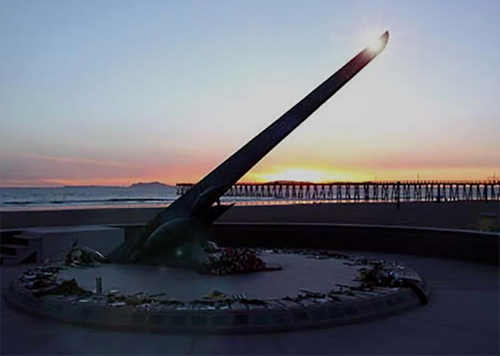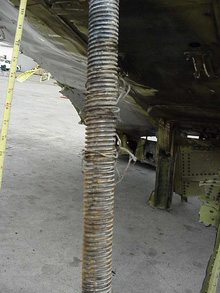The 20-year anniversary of Flight 261Maintenance error led to the death of 88By DAVE KIFFER January 30, 2020
AK 261 was a scheduled flight from Puerto Vallarta to Seattle with a stop in San Francisco. For a variety of reasons, it was not a full flight and because of that it was packed with people who were connected in some way with Alaska Airlines. Thirty five of the passengers and crew were either Alaska/Horizon employees or their dependents. The crash would cast a pall over the airline for many years. The plane, a twin-engine McDonnell Douglas MD-83 was less than a decade old and had more than 26,000 flight hours. The crew was very experienced. Captain Ted Thompson, 53, had 17,750 flight hours and 4,000 hours on MD jets. First Officer, Bill Tansky, 57, and more than 8,000 flight hours, the majority of which where in MD jets. There were three flight attendants on board, Alison Shanks, Craig Pulanco and Kristen Mills.
AK 261 left Puerto Vallarta at 1:37 pm Pacific Standard Time. The first leg – to San Francisco – was expected to take just under four hours. The first two hours – at a cruising altitude of 31,000 went as normal, but as the jet was approaching the Los Angeles area, the crew contacted Alaska’s dispatch and maintenance operation in Seattle. The crew was having trouble with a jammed horizontal stabilizer and was considering diverting to Los Angeles International Airport and landing. The horizontal stabilizer is crucial to keeping a jet stable in flight as pilots can use it to make slight adjustments. In this case, the jammed stabilizer was causing the pilots to keep a constant pressure on the control yoke to keep the plane steady. With the assistance of the maintenance techs, the pilots tried several things to free the yoke, but they were unsuccessful. Meanwhile, the crew was in contact with the AK Air dispatch office about diverting the flight to Los Angeles. That sparked a slightly testy exchange with the pilots, who replied that they were more concerned about not “overflying” a suitable diversion airport than they were about “flow.”
Since the problem with the jammed stabilizer couldn’t be fixed the pilots decided to attempt to land in Los Angeles. As they were making those preparations, the jammed stabilizer broke free. But then it immediately moved into what the report called “an extreme nose down position.” The jet went into an almost vertical nose-dive that lasted for 80 seconds and took the plane from 31,000 feet to just about 23,000 feet before the pilots managed to regain control of the aircraft. They continued to prepare the plane for an emergency landing in Los Angeles. In consultation with the LA tower, the crew decided to continue to decrease altitude and prepare for landing, but to do it out over the ocean until they were sure they had the plane under control. About 15 minutes after the initial dive, a second catastrophe hit the doomed the jet. The report notes that the cockpit voice recorder picked up four distinct “thumps” And then an extremely loud noise. Later it was determined that noise the was sound of the “jackscrew” assembly in the stabilizer completely failing. The jet pitched into another steep dive, which was witnessed by several other airplanes in the area which had been asked to keep visual contact with AK 261. No additional radio contact was made with the jet, but several of the other jets reported that AK 261 was heading, out of control, toward the ocean. Less than two minutes later, the other pilots reported that AK 261 had hit the ocean at a high rate of speed. The crash point was 14 miles offshore of Port Hueneme, a coastal community just north of Los Angeles. In examining the cockpit voice recorder and the airplane’s black box, investigators determined that for the last minute of the flight, the plane had actually been descending “inverted” or upside down. It’s hard to imagine what that horror was like for the passengers on AK 261. After the plane wreckage and the passengers bodies were recovered the investigation immediately focused on the horizontal stabilizer and the jackscrew that controlled it. The jackscrew and the acme nut that it operated through were both recovered. The 22-inch long jackscrew was found wrapped in metallic filaments which were determined to be the remains of the acme-nut thread. The investigation further determined that 90 percent of the acme nut thread had been worn away before the fatal flight. Once the thread failed completely, on the flight, the stabilizer was subjected to forces beyond its design capacity and failed completely, causing the pilots to lose control of the plane. What caused the thread to fail and bring the airplane down? Improper maintenance. In fact, the investigation determined that there was no lubricant at all on the jackscrew and the acme nut at the time of the accident. The cause of the crash, according to the NTSB was because of excessive wear caused because Alaska Airlines did not sufficiently lube the jackscrew. “This is a maintenance accident,” wrote NTSB board member John Goglia. “Alaska Airlines' maintenance and inspection of its horizontal stabilizer activation system was poorly conceived and woefully executed. The failure was compounded by poor oversight... Had any of the managers, mechanics, inspectors, supervisors or FAA overseers whose job it was to protect this mechanism done their job conscientiously, this accident cannot happen... NTSB has made several specific maintenance recommendations, some already accomplished, that will, if followed, prevent the recurrence of this particular accident. But maintenance, poorly done, will find a way to bite somewhere else.” The report found that Alaska Airlines had incorrectly increased the maintenance interval for the jackscrew and then its mechanics – when it was worked on in San Francisco – had completed the process in less than an hour, even though the McDonnell Douglas manual said the process should take four hours. The NTSB also faulted McDonnell Douglas for not designing a fail-safe mechanism in the stabilizer. The NTSB – when it investigated the Alaska Airlines maintenance procedures – discovered the airline out of compliance in numerous areas and also determined that the FAA – which was supposedly conducting oversight – was basically asleep at the wheel and not enforcing the appropriate guidelines. It also faulted the FAA for allowing Alaska Airlines to extend maintenance intervals without considering whether or not safety could be compromised. And interesting sidelight of the NTSB investigation was that it uncovered an investigation that had been taking place because an airline mechanic had reported to federal authorities that Alaska Airlines was forging maintenance records. The mechanic became part of an undercover investigation that was still going on when the crash occurred. One of the things that the mechanic was concerned about was that he had recommended – 1997 - replacement of the jackscrew on the AK 261 MD 83 that later crashed. His recommendation was overruled by a supervisor. Jackscrews similar to the one that failed on AK 261 were also used on the Space Shuttle and other NASA vehicles and they were redesigned after the crash of AK 261. For their efforts to control the stricken airliner and their decision to take it off-shore to avoid potential ground casualties, Captain Thompson and First Officer Tansky were each awarded the Air Line Pilots Gold Medal for Heroism. Although most of the victims of AK 261 were residents of Washington and Northern California, there were six Alaskans killed in the crash. Janice Stokes of Ketchikan, an employee of the Alaska Marine Highway, died along with her fiancé Malcom Branson of Seward, also a state ferry worker. Stokes was the president of the local state employees union and was instrumental in the creation of the Ketchikan Lost at Sea memorial near the ferry terminal. Her name – and Branson’s – were added to the memorial. Former Doyon Corporation President Morris Thompson also died in the crash, along with his wife Thelma and his daughter, Sheryl. There is currently a memorial on the beach near Port Hueneme that includes the names of the 88 victims and a sundial that casts a shadow on the memorial plaque at 4:22 pm each January 31.
On the Web:
Contact Dave at dave@sitnews.us Dave Kiffer ©2020 Publication fee required. © Representations of fact and opinions in comments posted are solely those of the individual posters and do not represent the opinions of Sitnews.
|
|||||




